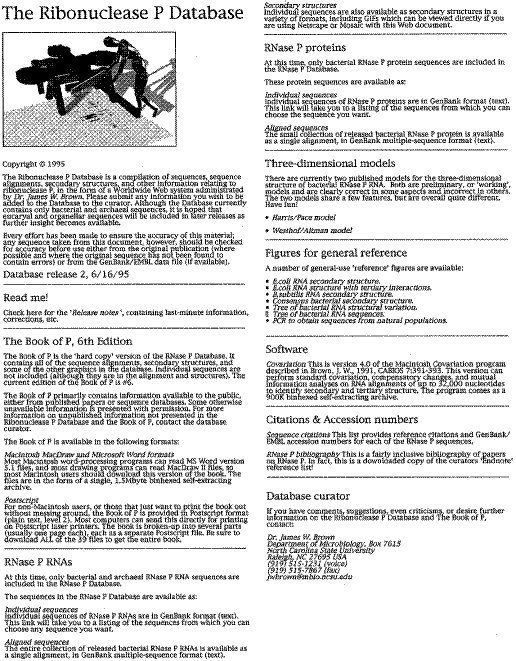Department of Microbiology, North Carolina State University, Raleigh, NC 27695.
Nucleic Acids Research (1996) 24:236-238.
ABSTRACT
Ribonuclease P is the endoribonuclease responsible for the removal of leader sequences from tRNA precursors. Ribonuclease P is a ribonucleoprotein, and in Bacteria the RNA alone is capable of pre-tRNA processing in vitro, i.e. it is a catalytic RNA. The Ribonuclease P Database is a compilation of ribonuclease P sequences, sequence alignments, secondary structures, three-dimensional models, and accessory information, in the form of a hypertext document available via the Worldwide Web.
INTRODUCTION
Ribonuclease P is the ribonucleoprotein endonuclease that cleaves transfer RNA precursors, removing 5'-precursor sequences and generating the mature 5' terminus of the tRNA (see reference [1] for review). In Bacteria, in which RNase P is best-understood, the holoenzyme consists of two subunits, an RNA of ca. 400 nucleotides (140kD) and a protein of ca. 120 amino acids (14kD) [2]. The RNA is the catalytic subunit of the holoenzyme; bacterial RNase P RNA is active, at high ionic strength in vitro, in the absence of the protein subunit [3]. Our knowledge of the higher-order structure of RNase P RNA has come primarily from comparative analysis. In the last year, the number of bacterial RNase P RNA sequences available for analysis has more than doubled (to nearly 100), thanks to improved cloning methods and the determination of sequences cloned from mixed microbial populations [4].
On a yearly basis since 1991, RNase P RNA sequence alignments and secondary structures have been compiled and distributed in an informal publication, 'The Book of P', providing workers in the field a single source for comparative information. In 1994 the Ribonuclease P Sequence Database was established as an electronic means of distributing the Book of P and its second release (described here) has been developed into a rich Worldwide Web hypertext database.
DESCRIPTION
The Ribonuclease P Sequence Database is a compilation of RNase P sequences, sequence alignments, secondary structures, three-dimensional models, and accessory information available electronically via Internet (see below for details on accessing the database). The hypertext format of the database makes access to its various components straightforward. The database primarily contains information on bacterial RNase P, focusing on the RNA subunit of the enzyme. Some information is also included on the archaeal, eucaryal, and organellar RNase P RNAs. The database is updated as additional sequences and structural information becomes available.
The bacterial and archaeal RNase P RNA sequences in the database are available from lists arranged phylogenetically as individual sequences or an alignment in Genbank format. Secondary structures of each RNA are presented in Graphic Interchange Format (GIFs) and can be downloaded as high-quality Postscript files. Models of the three-dimensional structure of the RNA are provided in Protein Database (PDB) format and as Quicktime movies. The handful of currently available bacterial RNase P protein subunit sequences are also available as individual sequences or as an alignment. Accessory information, such as reference structures, phylogenetic trees, and Genbank accession numbers and reference listings are also made available as part of the database.
The hard-copy version of the RNase P Database, the 'Book of P', contains all of this information compiled into a single document. The Book of P is available in the database in Apple Macintosh formats (MacDraw and Microsoft Word) that can be readily imported into most drawing or word-processing programs on this machine. The Book of P is also provided in Postscript format, which can be readily downloaded to any Postscript-capable printer from any computer platform.
AVAILABLITY
The Ribonuclease P Database is accessible using any Web reader at the URL ftp://iubio.bio.indiana.edu/molbio/rnase-p/home.html. Those without Web access can obtain the files by anonymous FTP. Hard copies of the Book of P are also available for those without electronic access to the database upon request. The administrator of the Ribonuclease P database (J.W. Brown) can be contacted by electronic mail (jwbrown@mbio.ncsu.edu) or by mail at the address given above. Users of the Ribonuclease P Database should cite this publication, and are encouraged to provide corrections, new information, or other materials for inclusion in the database; unpublished information will be held confidential at the authors request.
Acknowledgement
The author would like to thank Dr. Don Gilbert, the administrator of the Indiana University Biology Archives, not only for technical assistance with establishing and providing a home for the Ribonuclease P Database, but for his years of service to the biocomputing community worldwide.
REFERENCES

Figure. The Ribonuclease P Database 'Home page'. The appearence of the Ribonuclease P Database home page is shown as it appears in graphics-capable Worldwide Web browsers, e.g. Mosaic or Netscape. Links to the various sections of the Ribonuclease P Database are italicized.